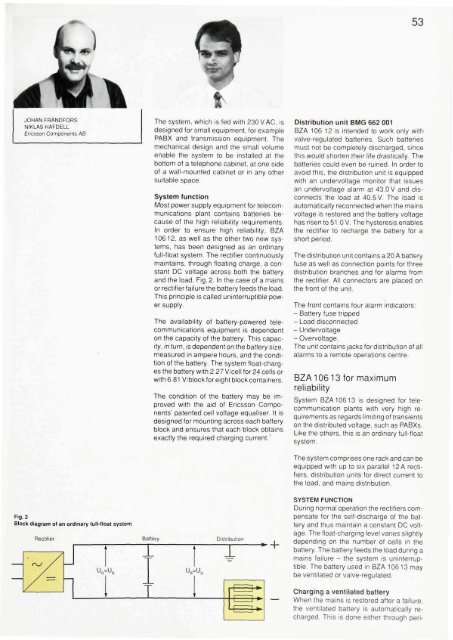Dichroic Antenna Reflector for Space Applications CCITT ...
Dichroic Antenna Reflector for Space Applications CCITT ...
Dichroic Antenna Reflector for Space Applications CCITT ...
You also want an ePaper? Increase the reach of your titles
YUMPU automatically turns print PDFs into web optimized ePapers that Google loves.
JOHAN FRANDFORSNIKLAS HAFDELLEricsson Components AB53The system, which is fed with 230 VAC, is Distribution unit BMG 662 001designed <strong>for</strong> small equipment, <strong>for</strong> example BZA 106 12 is intended to work only withPABX and transmission equipment. The valve-regulated batteries. Such batteriesmechanical design and the small volume must not be completely discharged, sinceenable the system to be installed at the this would shorten their life drastically. Thebottom of a telephone cabinet, at one side batteries could even be ruined. In order toof a wall-mounted cabinet or in any other avoid this, the distribution unit is equippedsuitable space.with an undervoltage monitor that issuesan undervoltage alarm at 43.0 V and disconnectsthe load at 40.5 V. The load isSystem functionMost power supply equipment <strong>for</strong> telecommunicationsplant contains batteries bevoltage is restored and the battery voltageautomatically reconnected when the mainscause of the high reliability requirements. has risen to 51.0 V. The hysteresis enablesIn order to ensure high reliability, BZA the rectifier to recharge the battery <strong>for</strong> a10612, as well as the other two new systems,has been designed as an ordinaryshort period.full-float system. The rectifier continuously The distribution unit contains a 20 A batterymaintains, through floating charge, a constantDC voltage across both the battery distribution branches and <strong>for</strong> alarms fromfuse as well as connection points <strong>for</strong> threeand the load, Fig. 2. In the case of a mains the rectifier. All connectors are placed onor rectifier failure the battery feeds the load. the front of the unit.This principle is called uninterruptible powersupply.The front contains four alarm indicators:- Battery fuse trippedThe availability of battery-powered telecommunicationsequipment is dependent - Undervoltage- Load disconnectedon the capacity of the battery. This capacity,in turn, is dependent on the battery size, The unit contains jacks <strong>for</strong> distribution of all- Overvoltage.measured in ampere hours, and the conditionof the battery. The system float-chargalarms to a remote operations centre.es the battery with 2.27 V/cell <strong>for</strong> 24 cells orwith 6.81 V/block <strong>for</strong> eight block containers. BZA 10613 <strong>for</strong> maximumreliabilityThe condition of the battery may be improvedwith the aid of Ericsson CompoSystem BZA 10613 is designed <strong>for</strong> telecommunicationplants with very high requirementsas regards limiting of transientsnents' patented cell voltage equaliser. It isdesigned <strong>for</strong> mounting across each batteryon the distributed voltage, such as PABXs.block and ensures that each block obtainsexactly the required charging current. 1 Like the others, this is an ordinary full-floatsystem.The system comprises one rack and can beequipped with up to six parallel 12A rectifiers,distribution units <strong>for</strong> direct current tothe load, and mains distribution,Fig. 2Block diagram of an ordinary full-float systemSYSTEM FUNCTIONDuring normal operation the rectifiers compensate<strong>for</strong> the self-discharge of the batteryand thus maintain a constant DC voltage.The float-charging level varies slightlydepending on the number of cells in thebattery. The battery feeds the load during amains failure - the system is uninterruptible.The battery used in BZA 10613 maybe ventilated or valve-regulated.Charging a ventilated batteryWhen the mains is restored after a failure,the ventilated battery is automatically recharged.This is done either through peri-















